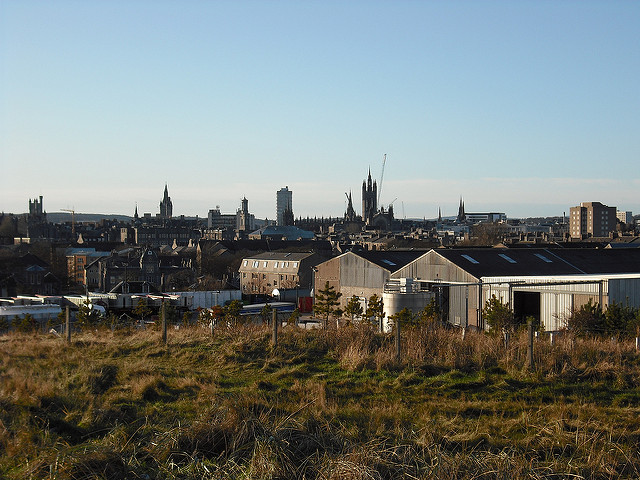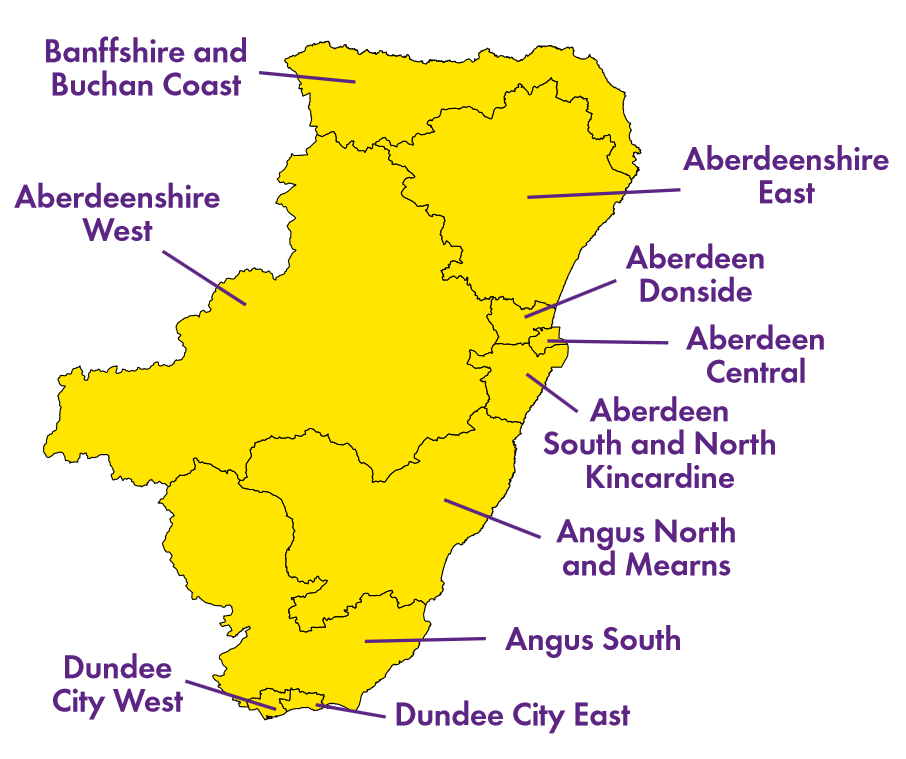Scottish Parliament election preview: Continued SNP dominance in the North East, but who will pick up the scraps?
The North East of Scotland contains Scotland’s third and fourth largest cities in Aberdeen and Dundee, with these cities representing ‘No’ and ‘Yes’ strongholds during 2014’s independence referendum. In the 2011 election, the SNP swept the board in this region, even managing to win a list MSP – something which the voting system in use was specifically designed to prevent. Here, Graeme Baxter and Iain MacLeod run the rule over the constituency and list contests, and predict continued SNP dominance.

Aberdeen, the region’s biggest city (Credit: kanshiketsu, CC BY SA 2.0)
The North East (hereafter NE) region comprises ten constituency seats (see Figure 1 below). We firstly consider these before moving on to the likely distribution of the region’s seven regional MSPs.
Figure 1: the NE Region and Constituencies

Source: the Scottish Parliament
Constituency Seats
Last year’s general election saw the SNP win all but three of Scotland’s constituency seats. This result had been strongly foreshadowed by their performance in the 2011 Scottish Parliament election, when they won a majority of seats in a system explicitly designed to prevent just such an outcome. This national dominance was mirrored in the NE constituencies, with the SNP taking all ten NE constituency seats. That dominance looks unlikely to change notably this year: ‘constituency vote’ polling figures point to a considerable strengthening of the SNP and the Conservatives since 2011, alongside a relative weakening of Labour and the Lib Dems.
Clearly, polling a representative sample at national level fails to capture important constituency-level factors, whereby voters may vote based on the quality of individual candidates than on the party they represent. It is also misleading to transpose national polls directly on to individual constituencies. However, if we put some faith in these opinion polls, how are these dynamics likely to play out? First and foremost, sitting SNP constituency MSPs (eight of their ten will defend their seats) are unlikely to feel particularly jittery. If Labour is to mount any sort of challenge at NE constituency level, it seems likeliest in two of the Aberdeen constituencies. Aberdeen Central represents their best chance: Lewis Macdonald will again contest the seat for Labour after narrowly losing out to the SNP’s Kevin Stewart in 2011. Another opportunity for Labour may be found in the Aberdeen Donside constituency: although Brian Adam won the seat for the SNP in 2011 with a comfortable majority (over 7k), his death in 2013 prompted a by-election at which Labour reduced this majority to around 2k.
Changes in personnel in two other NE constituencies may also weaken the SNP somewhat. Former First Minister Alex Salmond will step down in Aberdeenshire East to focus on his role as Westminster MP for the equivalent constituency (Gordon). His vacated seat will be defended by the previously untested Gillian Martin. With the NE proving fertile ground for the Lib Dems in previous elections (the seat was held by the Lib Dems from 1999-2007), they will look to make inroads into the huge 15k majority delivered by Salmond in 2011. However, national ‘constituency vote’ polling suggests that the Lib Dems have not experienced any notable post-Clegg bounce, consistently attracting the same level of support in constituency polls (approx. 4-6%) as during their time in coalition alongside the Conservatives at Westminster, and well short of the 18-19% they were polling prior to the 2007 election.
The other SNP incumbent not defending their seat is Nigel Don (Angus North & Mearns), who lost out to Councillor Mairi Evans in the selection process. With a majority of over 7k votes, Evans looks unlikely to be under serious threat, although her Conservative opponent Alex Johnstone (a regional MSP since 1999) is an experienced and weel kent local figure. This looks to be the Tories’ best chance of making inroads in NE constituency terms, although national polling again suggests that unseating the SNP is unlikely.
In each of the remaining seats, the SNP incumbents all have reasonably healthy majorities of at least 4k. In particular, Stewart Stevenson (Banffshire & Buchan Coast) and Shona Robison (Dundee City East) enjoy majorities of over 10k. Even the ill-judged assertion of Dennis Robertson (Aberdeenshire West) in January this year, that there was “no crisis” in the North Sea oil industry, seems unlikely to result in his being displaced from a seat where he won almost 43% of the vote in 2011.
In summary, given the strength of the SNP incumbents, the healthy majorities to protect in the two seats featuring changes of personnel, the trends emerging from ‘constituency vote’ opinion polling at national level and the lack of consistent traction being generated by other parties, it is difficult to see a situation in which the SNP fails to achieve a clean sweep of NE constituency seats.
Regional / List Seats
We now turn to consider the likely dynamics of voting on the regional component of the election in the NE. In doing so, we focus on two main areas, namely the relative standing of the different parties at national/regional level and the key issues within the region which are also likely to impact upon party list voting.
The 2011 result saw Labour win 3 regional seats, the Conservatives 2, and the SNP and Lib Dems 1 apiece. At that time, the regional vote intention polls (which closely reflected the ultimate distribution of regional votes at the election itself) aggregated across the whole of Scotland showed the SNP on 35%, Labour on 33%, the Conservatives on 13%, the Greens on 7% and the Lib Dems on 6%. Although there was a close match between late pre-election polling and the final results of the regional vote in the 2007 election, support for the SNP was again higher in the NE region than across Scotland as a whole, whilst the opposite was true for Labour.
A major shock in 2011 was the SNP managing to win a NE regional seat despite already having won all of the region’s constituencies. As the number of constituency seats won in the region is factored into the formula for allocating list MSPs to each party (i.e. acting as a ‘top-up’ corrective rather than direct proportionality), the SNP did not expect to win any NE regional seats. So strong was their performance (winning 53% of regional votes in the NE) that they overcame this hurdle and gained an additional MSP (Mark McDonald, who had been so confident of not being returned that he had attended the count in jeans and t-shirt).
If current polling at national level (which has shown support for the SNP ranging from 42% to 55% since the start of 2016) is adjusted upwards even slightly to reflect the fact that support for the SNP tends to be proportionately higher in the NE than across Scotland as a whole, the SNP may well claim a NE regional seat again this year. If we assume this to be the case and also adjust current national-level polls on regional voting intentions to reflect the slightly lower popularity of Labour in the NE (no such adjustment is required for the Tories and Lib Dems), it looks like it will be exceptionally tight between Labour and the Conservatives on the NE regional list. One of them will probably win three seats and the other only two, leaving one final seat up for grabs. At present, national-level polling on regional voting intention suggests this would go to the Greens (currently polling 10% compared to the Lib Dems’ 6%).
Buoyed by an almost eightfold increase in party membership since the beginning of 2014 and by the recent assurance from the BBC that they will receive a proportionate share of election campaign coverage (including at both of the BBC’s televised leaders’ debates), the Greens are currently in optimistic mood. However, as described above, the NE has long been a key source of support for the Lib Dems. Although the Greens did claim a NE regional seat in 2003, this was mainly due to the Lib Dems’ strong showing in the region’s constituencies (thus precluding their winning ‘top-up’ regional seats). With a similar level of constituency success virtually unthinkable in 2016, it is possible that the residual support for the Lib Dems in the NE may see them take the final regional seat. This is made more likely by a range of internal problems for the Greens in the NE, largely relating to the selection of the party’s co-convenor (Maggie Chapman) as their lead candidate on the list. Three of the party’s original ten list candidates quit amidst accusations of an unfair election process and allegations that Chapman had lied about her academic qualifications. The contest between the Lib Dems and Greens for this final seat is likely to be a close one.
The forthcoming referendum on EU membership may also play a role in the debate: indeed, the UK Independence Party (UKIP) was invited by the BBC to participate in its first televised leader’s debate, despite never having won a seat in the Scottish Parliament and having lost every Scottish constituency deposit at last year’s general election. Despite the contemporaneity of the party’s raison d’être, it has failed to consistently break the 5% barrier in regional voting intentions at Scottish elections. A breakthrough is not impossible but seems highly unlikely as every major party leader supports continued membership of the EU and will presumably attempt to avoid the issue on the campaign trail.
Certain issues may also play a role in support for the larger parties; particularly Labour and the SNP. It is impossible to discuss the NE region without referring to the dramatic fall in the price of oil since 2014. This has had enormous implications for Aberdeen in particular, with some estimates suggesting that up to half of the UK’s oil-related jobs (mostly based in and around Aberdeen) could be lost. There is potential for the industry’s ire to be turned on the current governing parties at Holyrood and Westminster, increasing the chances of a Labour resurgence. However, there is no clear evidence of any backlash against the SNP or Conservatives yet, with many in the region recognising the complex geopolitical machinations (rather than domestic political mismanagement) underlying the fall.
The continuing importance of constitutional preference may also affect voting dynamics, although the NE is a region divided. Whilst Aberdeen and Aberdeenshire voted strongly against independence (approx. 60/40), an equally large majority in Dundee supported independence: indeed, Dundee City was the local authority area most supportive of independence across the whole of Scotland. The fallout from the referendum has raised questions of tactical voting which could impact upon the NE. The key question is whether voters split their constituency and list votes as they did in 2003 (producing ‘the rainbow Parliament’) or whether they follow a partisan cue for both votes (as per 2011). There has been much murmuring about the possibility of ‘pro-independence’ split-ticket voting (i.e. voting for the SNP constituency candidate and giving the regional vote to a different pro-independence party) in order to maximise the number of pro-independence regional list MSPs returned. In this respect, and with recent survey research showing that the typical ‘Yes’ campaigner in 2014 is ‘significantly to the left’ of the SNP on key policy issues, the performance of RISE (the new alliance which offers a more robustly left-wing case for independence) will be of great interest. The alliance appears to be picking its NE region battles shrewdly: the only 2 candidates on its regional list are very strongly linked to Dundee/Tayside, and it is here that they will presumably focus their campaigning efforts.
One final factor to consider is the extension of the franchise to 16-17 year olds. Despite this being the first Scottish election at which they can vote, there has been a notable lack of dedicated opinion polling on their voting intentions, making their potential impact unclear. It will also be interesting to see what turnout will be among those aged 16-17: work we have conducted previously suggests that extension of the franchise for the 2014 referendum had a clear mobilisation effect on young people’s interest in politics, leading to a reported turnout of around 75% among those aged 16-17 in 2014. We will be watching with interest to see if a high level of turnout is also evident among those aged 16-17 this year, lending support to one of the key justifications deployed in support of extending the franchise.
—
 To find out more about the 2016 Scottish elections in your area, visit the Democratic Dashboard.
To find out more about the 2016 Scottish elections in your area, visit the Democratic Dashboard.
Note: this post represents the views of the author and not those of Democratic Audit or the LSE.It also appears on Democratic Audit – Scotland. Please read our comments policy before posting.
—
 Graeme Baxter is a Research Fellow and part-time Lecturer at Robert Gordon University, Aberdeen.
Graeme Baxter is a Research Fellow and part-time Lecturer at Robert Gordon University, Aberdeen.
 Iain MacLeod is a Lecturer at Robert Gordon University, Aberdeen
Iain MacLeod is a Lecturer at Robert Gordon University, Aberdeen





 Democratic Audit's core funding is provided by the Joseph Rowntree Charitable Trust. Additional funding is provided by the London School of Economics.
Democratic Audit's core funding is provided by the Joseph Rowntree Charitable Trust. Additional funding is provided by the London School of Economics.
Scottish Parliament election preview: Continued SNP dominance in the North East, but who will pick up the scraps? https://t.co/sqR1GvYKhu
Scottish Parliament election preview: Continued SNP dominance in the North East, but who will pick up the scraps? https://t.co/ywFHk8Y3UX
Latest election analysis from yours truly and Graeme Baxter for @democraticaudit: #holyrood2016 NE region preview – https://t.co/Gnqnu82uS6
Scottish Parliament election preview- Continued SNP dominance in the North East, but who will pick up the scraps? https://t.co/cHokrorh4t
Scottish Parliament election preview: Continued SNP dominance in the North East, but who will pick up the scraps? https://t.co/vSTJEi5dq4
Scottish Parliament election preview: Continued SNP dominance in the North East, but who will pick up the scraps? https://t.co/oMj3EIoln2
Scottish Parliament election preview: Continued SNP dominance in the North East, but who will pick up the scraps? https://t.co/VCfTvJiato
Scottish Parliament election preview: Continued SNP dominance in the North East, but who… https://t.co/sUEcfa5Utu https://t.co/yKUUsdNgxu